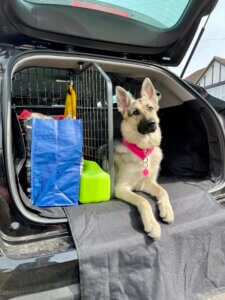We’ve all seen commercials of a family on a road trip with a very content dog in the vehicle who is overjoyed to be going on a car journey. For some dogs, being able to travel happily in the car comes easily. For others, getting to that happy-to-be-in the-car stage takes a bit longer. If you’ve had your dog from a puppy, you may have had to collect him quite a long way from where you live. For many puppies, being collected by their new forever family is their first experience of car travel. They are leaving their mother and the humans they have known from birth, to go off in a noisy contraption with strangers. You can understand why they’d be anxious. This anxiety, coupled with motion sickness for some, can mean that their first impressions of car travel aren’t good. So what can you do to help a dog that hates to travel in the car?
The first step is to insure that your dog is properly secured in the car. This gives him the feel that he has his own place in the vehicle. It also helps to avoid some driver distractions too. Adding a pet barrier and trunk divider such as the Travall Guard and Divider is a great choice to keep the dog in a secure comfortable area of the trunk away from other items you may be transporting.

The second step is to simply get your dog used to being in the car. To do this, put your dog in the vehicle where he would sit on a journey and have the driver sit in the driving seat. Start the car and, with the air conditioning running so the car is cool and comfortable, just sit there for a couple of minutes, but don’t actually leave the driveway. Get him familiar with the sensation of the vehicle when it is running and familiar with just being in the car. Reward good behaviors with treats and plenty of praise. Try this a few times then build up to driving the car around the block for a couple of minutes and back home again. Again give your dog plenty of praise and treats for good behaviors. Gradually extend the distance you travel, so that the dog’s confidence builds and he becomes more and more comfortable in the vehicle.
Take note of any anxiety and/or sickness on subsequent journeys. If the anxiety continues despite your car training attempts, the next step is to talk to your veterinarian about anti-anxiety options and/or anti-sickness medications that would be suitable for your dog.
We wish you many happy journeys ahead.
Information given in this article is not a substitute for advice from a qualified medical professional. Please consult a veterinarian for advice specific to your dog.